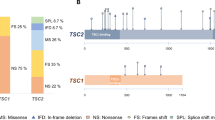Abstract
Tuberous sclerosis (TSC) is an autosomal dominant condition characterised by tumour-like malformations (hamartomas) in the brain and other organs. A proportion of hamartomas from patients with TSC show loss of heterozygosity (LOH) for DNA markers in the region of either the TSCI gene on chromosome 9834 or the TSC2 gene on 16p13.3. This implies that these lesions are clonal. We have studied X-chromosome inactivation, as a marker of clonality, in 13 hamartomas from females with TSC. The hamartomas comprised five renal angiomyolipomas, three fibromas and seven other lesions. In previous studies, four of the lesions showed LOH. A polymerase chain reaction assay was used to analyse differential methylation of anHpalI restriction site adjacent to the androgen-receptor triplet-repeat polymorphism on Xg11-12. In 12 of the lesions, there was a skewed inactivation pattern with one X chromosome being fully methylated and the other unmethylated. Normal tissue showed a random pattern of inactivation. These data confirm that most TSC hamartomas are clonal in origin. This is an intriguing finding, since these lesions are composed of more than one cell type.
Similar content being viewed by others
References
Allen RC, Zoghbi HY, Moseley AB, Rosenblatt HM, Belmont JW (1992) Methylation ofHpaII andHhaI sites near the polymorphic CAG repeat in the human androgen-receptor gene correlates with X chromosome inactivation. Am J Hum Genet 51:1229–1239
Carbonara C, Longa L, Grosso E, et al (1994) 9g34 loss of heterozygosity in a tuberous sclerosis astrocytoma suggests a growth suppressor-like activity also for the TSC1 gene. Hum Mol Genet 3:1829–1832
Fryer AE, Connor JM, Povey S, et al (1987) Evidence that the gene for tuberous sclerosis is on chromosome 9. Lancet 1:659–661
Giacoia GP (1992) Fetal rhabdomyoma: a prenatal echocardiographic marker of tuberous sclerosis. Am J Perinatol 9:111–114
Gomez MR (1991) Phenotypes of the tuberous sclerosis complex with a revision of diagnostic criteria. Ann N Y Acad Sci 615:1–7
Green AJ, Smith M, Yates JRW (1994a) Loss of heterozygosity on chromosome 16p13.3 in hamartomas from tuberous sclerosis patients. Nature Genet 6:193–196
Green AJ, Johnson PH, Yates JRW (1994b) The tuberous sclerosis gene on chromosome 9834 acts as a growth suppressor. Hum Mol Genet 3:1833–1834
Kandt RS, Haines JL, Smith M, et al (1992) Linkage of an important gene locus for tuberous sclerosis to a chromosome 16 marker for polycystic kidney disease. Nature Genet 2:37–41
Knudson AGJ (1971) Mutation and cancer: statistical study of retinoblastoma. Proc Natl Acad Sci USA 68:820–823
Maniatis TM, Fritsch EF, Sambrook J (1982) Molecular cloning: a laboratory manual. Cold Spring Harbour Laboratory, Cold Spring Harbor, NY
Munjal AK, Schultz S (1992) Adult onset of renal angiomyolipoma in a patient with tuberous sclerosis. Urol Radiol 14:144–147
Pullicino P (1993) Antenatal diagnosis of tuberous sclerosis. Lancet 341:176
Smith SA, Easton DF, Evans DRG, Ponder BAJ (1991) Allele losses in the region 17g12-21 in familial breast and ovarian cancer involve the wild type chromosome. Nature Genet 2:128–131
The European Chromosome 16 Tuberous Sclerosis Consortium (1993) Identification and characterisation of the tuberous sclerosis gene on chromosome 16. Cell 75:1–11
Author information
Authors and Affiliations
Rights and permissions
About this article
Cite this article
Green, A.J., Sepp, T. & Yates, J.R.W. Clonality of tuberous sclerosis harmatomas shown by non-random X-chromosome inactivation. Hum Genet 97, 240–243 (1996). https://doi.org/10.1007/BF02265273
Received:
Revised:
Issue Date:
DOI: https://doi.org/10.1007/BF02265273




